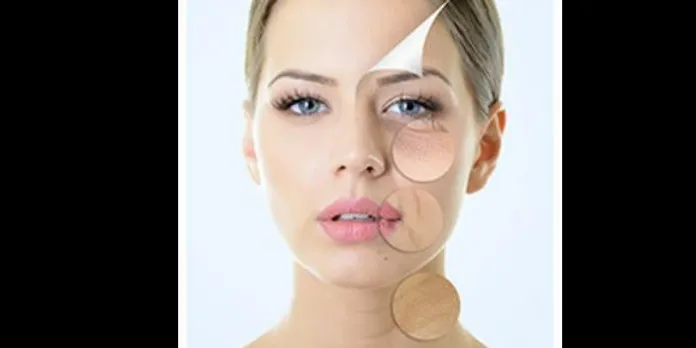Facial fine lines and wrinkles are the top three skin concerns among my patient's ages 30 to 50. I’ll share what contributes to the cause of these, and ways to reverse these conditions, including key product ingredients for daily use you really must know about. Let me first tell you how I feel about aesthetic medicine. No guilt aesthetics I practice integrative and functional medicine so my patients will feel better, and reverse and prevent disease. I also provide aesthetic medicine services at the same office. Some integrative medicine-minded patients balk at my aesthetic medicine, but why? Jealousy? Fear? I believe we all feel good when we look our best.
When departing San Diego airport this morning I was pleased to bump into my 53 y/o patient Janette, whom I treated four days ago with Xeomin (botulinum toxin A). With a beaming smile, she told me about the compliments she has already received. Botox drastically evened out her left face wrinkles to match her right residual facial paralysis caused by Ramsey-Hunt Syndrome years ago. Her genuine happiness reminded me how much I love aesthetic medicine.
You should know that in my office at San Diego Integrative Medicine and Spa, I work across the hall from my sweet wife, Julia. Her clients rave about their results—both online and while they are at the office. She is an expert at eyelash extension and semi-permanent make-up. It only makes sense that they feel best when they can look their best. This positive energy gives momentum to live a healthy lifestyle. Wouldn’t you know that now my other (“medical”) patients are starting to catch on to aesthetics—and are loving it?
Let’s consider the causes of facial fine lines and wrinkles.
Causes of facial fine lines (rhytids) Fine lines come from a few obvious conditions: too much artificial tanning or sun damage (ultraviolet light), smoking, genetic predisposition, and advancing age. Many people just don’t even realize that taking care of their skin is important—until it is too late.
Also, there are these other contributing causes to fine lines that often get overlooked: Nutrient-poor diet: this leads to weaker skin structure or inflammation due to subtle allergies, as explained here: https://easyhealthoptions.com/allergy-of-chronic-disease/. Stress that is frequent or prolonged causes cortisol over-production by your adrenal gland. The one of the symptoms of cortisol excess is accelerated skin aging. Exposure to harmful topical ingredients (in creams and lotions) or even chronic use of prescription medications. Constipation because it promotes systemic (total body) inflammation. When stool sits inside your colon too long (healthy is two BM daily), some of the chemicals in it are absorbed back into your bloodstream through the intestinal wall called the entero-hepatic circulation process. This means that toxic water insoluble wastes in the bile, intended for elimination, can be re-absorbed back into your bloodstream.
Treatment for fine lines This starts with reversing the contributing causes. The best way to do this I know of is to go on a liquid cleanse (Lemonade Cleanse or fresh juicing), followed by consistent consumption of mostly raw, whole food nutrition. Also, seldom consumption of processed foods high in sugar or refined oil or trans fats.
Treatment of fine lines then ranges from topical cosmeceutical creams to office procedures such as chemical peels, microdermabrasion, hyaluronic acid dermal filler injections, radiofrequency, IPL (intense pulsed light), and laser—all these are at your local medical spa. Let’s start with topical creams.
Topical creams Cosmeceuticals contain powerful anti-aging and healing ingredients to make your skin smoother, softer, and younger-looking. They are classified based on their ability to improve skin appearance (but not skin structure and function as drugs are).
Antioxidants protect skin cells from the damage caused by free radical molecules. Topical antioxidants are: Vitamin C (L-Ascorbic acid) is a vital nutrient for skin growth and repair, and one of the strongest antioxidants for skin. It is proven to prevent and reduce skin aging and wrinkles. It is expensive ($75-200 for a 2 to 3-month supply). The most effective formulation is 20% at a pH of 2 (very acid). Vitamin E (Alpha-tocopherol) claims to protect skin softness, prevent sun damage and delay skin aging. Dermatologists instead often recommend Aquaphor® to protect and smooth skin which contains petrolatum, panthenol (derived from B-vitamin), glycerin, and bisabolol (from chamomile). Polyphenols: resveratrol, green tea, soy, and coffeeberry contain polyphenols shown to reduce skin cancer, sun damage, and skin aging. Resveratrol (from grapes, berries, nuts, etc.) is the most potent one when formulated correctly. CoEnzyme Q-10 reduced wrinkles in 27% of users over 6 weeks in one study. Alpha lipoic acid 5% cream applied daily reduced sun damage (photo ageing) in a study of 33 women average age of 54 years in a 12-week placebo-controlled study.
Hydroxy acids such as glycolic acid and salicylic acid cause the removal of dead surface skin cells. They compare in effectiveness to Retin-A. Be aware of their risk of persistent redness, scarring, or cold sore flare-ups. Beauty spas and non-prescription creams contain 4 to 10% concentration for daily use, but be careful if you have very sensitive skin. Physicians can use 50-70% concentrations in their office for deeper chemical peels, typically trichloroacetic acid (TCA) for fine wrinkle reduction. Repeat treatment every 2 to 4 weeks for optimal results.
Peptides or amino acids increase cells in the skin to produce more collagen, the support structure of youthful skin. Originally these were marketed for healing stretch marks. The three main peptides are: Signal peptides increase collagen formation (e.g. Palmitoyl-pentapeptide, Peptamide-6) Carrier peptides activate enzymes to increase collagen and carry trace elements such as copper for wound healing (e.g. glycyl-l-histidyl-l-lysine) Enzyme-inhibiting peptides block collagen destruction and also relax muscles like Botox by blocking acetylcholine release (e.g. Argireline)
Growth factors and cytokines are vital molecules for skin repair and aging reversal. These naturally become depleted with age and current studies prove they increase dermal collagen.
Stem cells from plants, animals, human fat cells, and placental tissue/amniotic fluid have been proven to increase collagen, decrease wrinkles and promote wound healing. They are found in many serums and creams on the market already.
Vitamin A retinoids Natural retinoids are derived from Vitamin A and you don’t need a prescription to buy these. They are clinically proven to help visibly reduce both fine lines and deep wrinkles. They must be converted into pre-formed vitamin A. From weaker to stronger, these ingredients are retinyl palmitate, retinol, and then retinal aldehyde (a.k.a. “retinal”). Retinoic acid is the strongest natural retinoid. The prescription cream Tretinoin is retinoic acid in pharmaceutical form (Retin-A®, Renova®) and is dosed from 0.02% up to 0.1%. These treat more than just acne—now being prescribed for fine lines, to strengthen skin, and to stimulate new skin growth. Retin-A also treats keratosis follicularis (small red rough bumps on the back of your upper arms), psoriasis, and flat warts. Synthetic retinoids (a.k.a. retinoid analogs) are made in a laboratory and act like natural pre-formed vitamin A in your skin. These are by prescription only and (from weaker to stronger) are Adapalene (Differin®) Gel 0.1% to 0.3%, and Tazarotene (Tazorac®) cream 0.05% and 0.1%.
Wrinkles The most obvious wrinkles of the face are formed by underlying muscle contractions of facial expression. I encourage facial expressions when needed. However, have you noticed others who fairly consistently raise their eyebrows (frontalis—forehead muscles), squint their eyes (orbicularis oculi—around lateral eye muscles), or scowl (corrugator—glabella muscles that make the “11 lines” between the eyebrows)? Most of us do not even realize it, but you may notice it in others with prominent static facial wrinkles in these areas.
These are the wrinkles that are easily overcome by injection of botulinum toxin, which lasts 3 to 5 months per treatment.
In my next article I’ll share causes and treatments for sagging skin, the major aesthetic concern for my patients over age 50.
To long feeling good and looking good, Michael Cutler, M.D.









